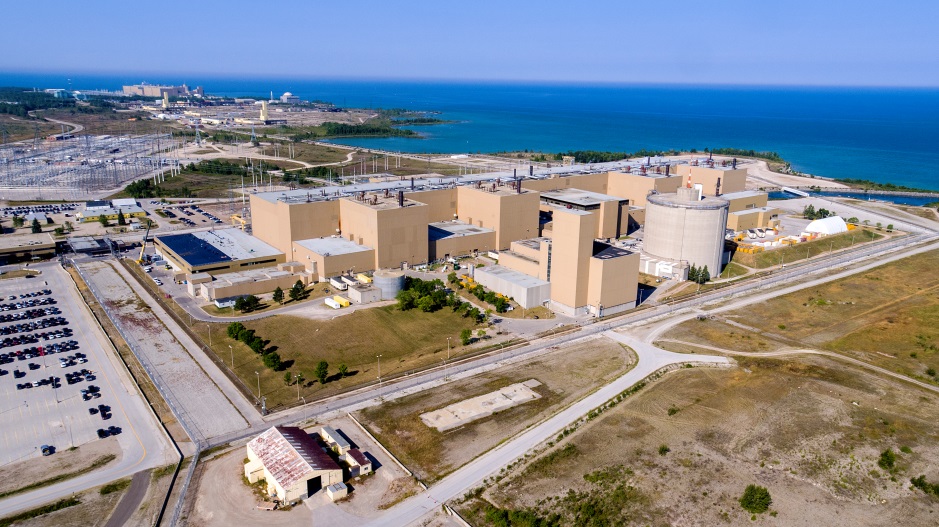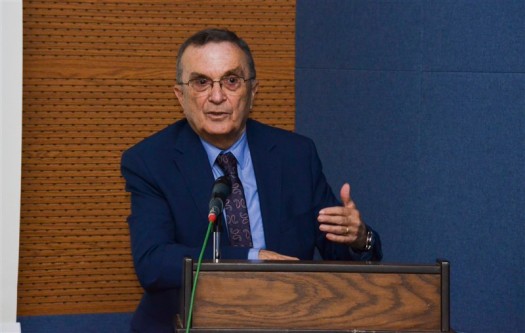
Since the 1960’s Turkey were trying to get involved with nuclear energy. Turkey was one of the countries that participated in the International Conference on the Peaceful Uses of Atomic Energy, held in Geneva in 1955 September. There is no doubt that Turkey wants to use nuclear energy for energy production. In Turkey, there are many experts that have knowledge about nuclear fission technology. Dr. Reşat Uzmen is one of the most important people who is experienced in the nuclear fuel area. During the interview, his ideas and visions enlighten us about the future of Molten Salt Fission Technology. Here is another instructive interview for building a MSR!

The Atoms for Peace symbol was placed over the door to the American swimming pool reactor building during the 1955 International Conference on the Peaceful Uses of Atomic Energy in Geneva, often called the Atoms for Peace conference.
Rana
President of the Student Guild
The Thorium Network
Mr. Reşat, can you tell us a little about yourself?
I graduated from İstanbul Technical University (İTU) in the chemical engineering department. I did my master’s degree in İTU also. As soon as I finished the department I became a researcher in The Çekmece Nuclear Research and Training Center, known as ÇNAEM. My research was about how uranium could be treated to obtain an uranium concentrate. I did my doctor’s degree in that topic. Back then, it was so hard to get information because it is a delicate technology. That’s why we did the research by ourselves. Think about that: there was no internet! There was a library in ÇNAEM, it still remains there. All the reports that were collected from all over the world were kept here. We benefit from those reports that were about uranium and thorium. In addition, getting chemicals was difficult. The ores that we were working on were coming from Manisa so mine was tough to process. Despite all these obstacles Turkey needed uranium so we have done what has to be done. I am the founder of “the nuclear fuel technology department in ÇNAEM”. This department was focused on producing uranium fuel that could be ready for fuelling and we did it. We produced uranium pellets by ourselves in our laboratories. We did research about ore sorting of thorium and how it can be used in nuclear reactors. Now I am working as a nuclear technology director at FİGES.

“Turkey is capable of designing its own reactor now!”
Dr. Reşat Uzmen
What are your thoughts on Turkey’s nuclear energy adventure? Although nuclear engineering education has been given at Hacettepe University since 1982, Turkey has never been able to gain an advantage in nuclear energy. What could be the main reasons for this?
Nuclear energy needs government support and government incentive. Government policy must include nuclear energy. In Turkey, nuclear energy was too personal. A government is formed then a team becomes the charge of the Turkey Atomic Energy Agency and this team is working hard, trying to encourage people about nuclear energy but then the new government is formed and the team is changed. Unfortunately, this is how it is done in Turkey. Also, you need money to build reactors. There were some countries that try to build a nuclear reactor in Turkey. Once CANDUs was very popular in Turkey. Canadians supported us a lot. Argentineans came with CAREM design and wanted to develop the design with Turkey also they wanted to build CAREM in Turkey, it was a great offer but the politicians at that time were not open up to this idea. Nuclear energy must be government policy and it should not be changed by different governments.
As you know, there is a PWR-type reactor under construction in cooperation with Rosatom and Akkuyu in our country. Do you think Turkey’s first reactor selection was the right choice?
This cooperation is not providing us any nuclear technology. When The Akkuyu Nuclear Power Plant is finished we will have a nuclear reactor that is operating in Turkey but we can not get any nuclear technology transformation. Right now Turkey can not construct the sensitive components of a nuclear reactor. Akkuyu is like a system that produces energy for Turkey. It would be the same thing if Russia build that plant in a place that is near Turkey. In addition, there is the fate of spent fuels. Russia takes away all the spent fuels, these spent fuels can be removed from Turkey in two ways: by water, starting from the Akkuyu harbor, the ship will pass through the Turkish straits, then pass to the Black Sea and pass through the Novorossiysk harbor to reach Siberia and by land, from Akkuyu it will arrive in Samsun or Trabzon then by water the ship will arrive in Siberia. I suppose spent fuels are going to be transported by water.
What are your thoughts on molten salt reactors?
Molten Salt Reactor is a Gen. 4 reactor and has a lot of advantages. First of all, the fuel of the MSR is molten salt so it is a liquid fuel. Since I am interested in the fuel production part of nuclear energy I am aware of the challenges of solid fuel production. Having liquid fuel is a big virtue. Liquid fuel can be ThF4-UF4. The fuel production step can proceed as: UF4 may be imported as enriched uranium. If you have the technology then UF₆ may be imported as enriched uranium then UF₆ can be converted to UF4. After that step fabrication of the liquid fuel is easier than solid fuel. Second, MSR has a lot of developments in the safety systems of a nuclear reactor. There is no fuel melting danger because it is already melted. The liquid fuel is approximately 700 °C. The important point is molten salt may freeze. If fuel temperature is below approximately 550°C the fuel becomes solid we don’t want that to happen. Also, the fuel has a negative temperature coefficient which means that as the temperature of the fuel rises reactivity of the fuel is going to decrease. There is a freeze plug at the bottom of the core. If the core overheats the freeze plug will melt and the contents of the core will be dropped into a containment tank fed by gravity. This is a precaution against the loss of coolant accident. One of the other advantages is reprocessing opportunity. It is possible with helium to remove volatile fission products from the reactor core. Tritium can be a problem but if the amount of tritium is below the critical level then it wouldn’t be a problem.
” Molten Salt Reactors are advantageous in many ways. The fuel is already melted, freeze plug is going to melt in case of an overheating issue, reproccessing is easier than the solid fuel. ”
FİGES took on the task of designing MSR’s heat exchangers in the SAMOFAR project and your designs were approved. Can you talk a bit about heat exchangers? What are the differences with a PWR exchanger? Why did it need to be redesigned?
There are a lot of differences between a PWR heat exchanger and an MSR heat exchanger. The basic difference is, that in a PWR heat exchanger steam is produced from water. MSR heat exchanger is working with molten salt to produce steam. FİGES finished calculations like the flow rate of the molten salt, the temperature of the molten salt, etc. for a heat exchanger of SAMOFAR. The heat exchanger is made of a material that is the same as the reactor core. In SAMOFAR, Hastelloy is used but boron carbide sheeting may be used for the heat exchanger.
Can you talk a little bit about your collaboration with Thorium Network?
The Founder of the Thorium Network Jeremiah has contacted FİGES about 5 months ago. We met him in one of the FİGES offices which are located in İstanbul. We have discussed what we have done in Turkey thus far. We signed an agreement about sharing networks. We share the thorium and molten salt reactor-based projects with them and they do the same.
If the idea of building an MSR in Turkey is accepted, where will FİGES take part in this project?
As FİGES, building an MSR in Turkey has two steps. The first step is about design. To design a reactor you need software. The existing codes are for solid fuel. First of all the codes that are going to be used for liquid fuel must be developed. There are companies that work to develop required software all around the world. We want to take part in the design step as FİGES. After the design is finished the second step comes. The second step is building the reactor. FİGES doesn’t have the base to build a reactor but an agreement can be made with companies that can build a nuclear power plant.
Do you have any advice you can give to nuclear power engineer candidates who want to work on MSR? What can students do about it?
There are tons of documents about Molten Salt Reactor Technology. These documents are about the material of the reactor core, software codes, design, etc. A student can find everything about MSR on the internet. In addition to this, students should follow the Denmark-based company that is called “Seaborg“. They have a compact molten salt reactor design. Also, there is another MSR design called “ThorCon“. Students can follow the articles, presentations, and events about these two MSR designs. As I said, students must research and follow the literature about Molten Salt Fission Technology.
. . .
It was a great opportunity for me to meet Mr. Reşat who has been working to develop nuclear energy in Turkey. I would like to thank him for his time and great answers.
As students, we are going to change the world step by step with Molten Salt Fission Technology by our side. We are going to continue doing interviews with key people in nuclear energy and MSR!
The Student Guild of the Thorium Network
LINKS AND REFERENCES:
- Dr. Reşat Uzmen on Linkedin
- Rana on Linkedin
- The interview on Youtube
- Figes AS
- SAMOFAR
- Atoms for Peace
- Interview #2, Mr. Emre Kiraç “Leading to Nuclear”
- Launching “Leading to Nuclear, Interviews by the Thorium Network Student Guild”
- The Thorium Student Guild
#ThoriumStudentGuild #LeadingToNuclear #Interview #ResatUzmen #Figes #Turkey






















You must be logged in to post a comment.